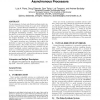Free Online Productivity Tools
i2Speak
i2Symbol
i2OCR
iTex2Img
iWeb2Print
iWeb2Shot
i2Type
iPdf2Split
iPdf2Merge
i2Bopomofo
i2Arabic
i2Style
i2Image
i2PDF
iLatex2Rtf
Sci2ools
CASES
2007
ACM
2007
ACM
Performance-driven syntax-directed synthesis of asynchronous processors
The development of robust and efficient synthesis tools is important if asynchronous design is to gain more widespread acceptance. Syntax-directed translation is a powerful synthesis paradigm that compiles transparently a system specification written in a high-level language into a network of pre-designed handshaking modules. The transparency is provided by a one-to-one mapping from language constructs to the module networks that implement them. This gives the designer flexibility, at the language level, to optimise the resulting circuit in terms of performance, area or power. This paper introduces new techniques that exploit this flexibility to improve the performance of synthesised asynchronous systems. The results of a series of transistor level simulations show that these techniques, combined with optimised handshake module implementations, can produce close to a ten-fold improvement in the performance of a 32bit, ARM-compatible, asynchronous processor used in an experimental smar...
Asynchronous | CASES 2007 | Efficient Synthesis Tools | Powerful Synthesis Paradigm | System Software |
| Added | 12 Aug 2010 |
| Updated | 12 Aug 2010 |
| Type | Conference |
| Year | 2007 |
| Where | CASES |
| Authors | Luis A. Plana, Doug A. Edwards, Sam Taylor, Luis A. Tarazona, Andrew Bardsley |
Comments (0)

